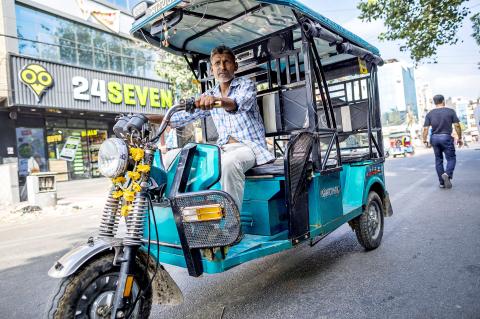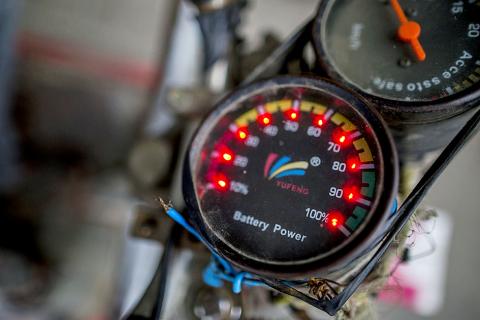An electric-vehicle (EV) revolution is gaining ground in India and it has nothing to do with cars.
The South Asian nation is home to about 1.5 million battery-powered, three-wheeled rickshaws — a fleet bigger than the total number of electric passenger cars sold in China since 2011, but while the world’s largest auto market dangled significant subsidies to encourage purchases of battery-powered cars, India’s e-movement hardly got a hand from the state.
Rather, drivers of the ubiquitous three-wheelers weaving through crowded, smoggy streets discovered that e-rickshaws are quieter, faster, cleaner and cheaper to maintain than a traditional auto rickshaw.

Photo: Bloomberg
They also are less strenuous than cycle rickshaws, which require all-day peddling. So with more rides possible in a day, the e-rickshaws are proving more lucrative.
As many as 11,000 new e-rickshaws hit the streets every month, and annual sales are expected to increase by about 9 percent by 2021, consulting firm A.T. Kearney said.
Three-wheeled vehicles make up a US$1.5 billion market, and manufacturers of electric versions include Mahindra & Mahindra Ltd and Kinetic Engineering Ltd, along with smaller outfits that assemble parts imported from China.

Photo: Bloomberg
“This is a once-in-a-lifetime, transformational opportunity that we’re looking at,” said Goldie Srivastava, chief executive officer and cofounder of SmartE, an Uber-style app using 800-plus e-rickshaws around New Delhi. “When we look at electric mobility, the focus should be: Are you as a government enabling products that are designed for the future?”
India’s dominant ride-hailing start-up, Ola, plans to place 10,000 e-rickshaws in its service by next April.
India is the world’s fourth-largest auto market, but previous attempts to boost private electric-car ownership flopped. The government likely scaled back because it fears disrupting an industry that contributes about 7 percent of the total gross domestic product, a Bloomberg New Energy Finance (BNEF) report said in March.
Unlike the estimated 1.35 million passenger EVs cruising around China, the number of electric cars plying Indian roads is a paltry 6,000, BNEF data showed.
Chinese automakers sell more than that in three days.
India’s largest automaker, Maruti Suzuki India Ltd, is unlikely to sell its first EV until 2020.
Indian Prime Minister Narendra Modi’s administration is pivoting toward promoting EVs in public transportation and fleet operations, primarily with two and three-wheelers, taxis and buses. The Ministry of Finance is finalizing a plan to spend about 40 billion rupees (US$547 million) in the next five years to improve the nation’s charging infrastructure and subsidize e-buses.
“India needs to focus on electrifying two-wheelers and three-wheelers,” said Amitabh Kant, chief executive officer of the National Institution for Transforming India (NITI Aayog), a government policy institute helping to formulate the new strategy.
Outside an east Delhi metro station, a slew of partly open-air vehicles line the street as commuters hail their rides. They also carry tourists, schoolchildren, crates of fruit and the occasional goat.
Anil Chaudhary, 32, switched to an e-rickshaw from a cycle model two years ago. His income increased, he is able to take longer breaks and he sends money to his wife and three children in Bihar, about 1,100km away.
He is already on his second electric model.
“Two months ago, I called my brother from the village and gave him my old e-rickshaw so that he could drive it,” he said as a goat strolled past.
“I’ve bought this new one,” he said, gesturing toward a glossy, red vehicle adorned with paper flowers and an Indian flag.
Then there is the ameliorative effect that e-rickshaws have on the toxic air in India, home to 10 of the world’s most polluted cities, according to the WHO.
A total of 635,698 three-wheel vehicles were sold during the fiscal year that ended in March — a 24 percent increase from a year earlier, the Society of Indian Automobile Manufacturers said.
By comparison, about 3.3 million passenger cars were sold, mostly all powered by gasoline or diesel.
One hindrance to the potential growth of EVs is the lack of charging and battery-swapping stations nationwide.
India had about 425 publicly available charging points at the end of last year. By 2022, government and private efforts are expected to boost that to an estimated 2,800 charging points, BNEF said.
Instead of waiting, some companies are starting to build their own infrastructure.
SmartE has partnered with Delhi Metro Rail Corp to provide charging near 10 stations, with plans to expand throughout the 214-station system by the end of 2020.
Another hindrance is the lack of bank financing for traditional rickshaw drivers, who typically earn low incomes, said Shishir Agrawal, managing director of Shigan eVoltz Ltd, the parent company of manufacturer GreenRick.
The company, which sells e-rickshaws mostly in Delhi and Uttar Pradesh, could more than triple production to 1,000 vehicles a month if that issue is resolved. The potential market for e-rickshaws could be sales of 20 million vehicles a year, he said.
“If the subsidies get better, and easy financing options become available, this market is unstoppable,” Agrawal said.

Intel Corp chief executive officer Lip-Bu Tan (陳立武) is expected to meet with Taiwanese suppliers next month in conjunction with the opening of the Computex Taipei trade show, supply chain sources said on Monday. The visit, the first for Tan to Taiwan since assuming his new post last month, would be aimed at enhancing Intel’s ties with suppliers in Taiwan as he attempts to help turn around the struggling US chipmaker, the sources said. Tan is to hold a banquet to celebrate Intel’s 40-year presence in Taiwan before Computex opens on May 20 and invite dozens of Taiwanese suppliers to exchange views

Application-specific integrated circuit designer Faraday Technology Corp (智原) yesterday said that although revenue this quarter would decline 30 percent from last quarter, it retained its full-year forecast of revenue growth of 100 percent. The company attributed the quarterly drop to a slowdown in customers’ production of chips using Faraday’s advanced packaging technology. The company is still confident about its revenue growth this year, given its strong “design-win” — or the projects it won to help customers design their chips, Faraday president Steve Wang (王國雍) told an online earnings conference. “The design-win this year is better than we expected. We believe we will win

Chizuko Kimura has become the first female sushi chef in the world to win a Michelin star, fulfilling a promise she made to her dying husband to continue his legacy. The 54-year-old Japanese chef regained the Michelin star her late husband, Shunei Kimura, won three years ago for their Sushi Shunei restaurant in Paris. For Shunei Kimura, the star was a dream come true. However, the joy was short-lived. He died from cancer just three months later in June 2022. He was 65. The following year, the restaurant in the heart of Montmartre lost its star rating. Chizuko Kimura insisted that the new star is still down

While China’s leaders use their economic and political might to fight US President Donald Trump’s trade war “to the end,” its army of social media soldiers are embarking on a more humorous campaign online. Trump’s tariff blitz has seen Washington and Beijing impose eye-watering duties on imports from the other, fanning a standoff between the economic superpowers that has sparked global recession fears and sent markets into a tailspin. Trump says his policy is a response to years of being “ripped off” by other countries and aims to bring manufacturing to the US, forcing companies to employ US workers. However, China’s online warriors